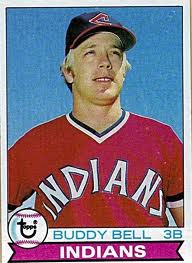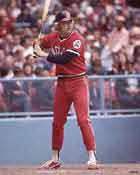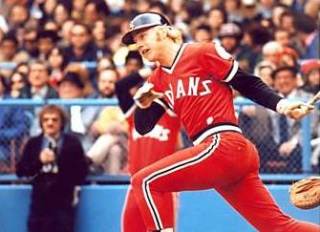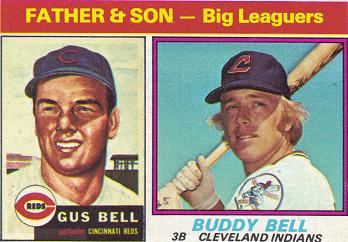 Indians Archive
Indians Archive  Blast From The Past: Buddy Bell, Fellow Star Third Baseman
Blast From The Past: Buddy Bell, Fellow Star Third Baseman
 Suddenly, he knew it was time to step up. He was thirteen years old now. He was among the throng of Cleveland Indians fans who’d arrived at that sunny public park in Willowick in 1973. Yes, he was star-struck, but he was old enough to avoid acting like it. Before the autograph session began, someone in charge had unexpectedly invited questions for the Tribe’s third baseman of the present and future, Buddy Bell.
Suddenly, he knew it was time to step up. He was thirteen years old now. He was among the throng of Cleveland Indians fans who’d arrived at that sunny public park in Willowick in 1973. Yes, he was star-struck, but he was old enough to avoid acting like it. Before the autograph session began, someone in charge had unexpectedly invited questions for the Tribe’s third baseman of the present and future, Buddy Bell.
Buddy Bell was part of what was good about the Indians of the 1970s. He had played second base as a boy, switching to third base as a 18 year old minor leaguer in 1970. Bell was in the starting lineup with the big league team as a rookie in 1972 -but as the right fielder. Third base was spoken for; Graig Nettles had the look of a future star.
The young teenager was determined to seize this opportunity to talk baseball with Bell, his hero that summer. After all, he was a pretty decent third baseman himself. Over the previous few seasons, he had perfected diving toward the third base line, turning doubles into outs. Such diamond wizardry drew comparisons to World Series star Brooks Robinson of the Baltimore Orioles. Actually, our young fan either made such plays, or repeatedly imagined himself doing so- whichever was the case isn’t important right now. But this season, he’d noticed Buddy Bell’s knack for charging a bunt, and with his footwork just right, scooping the ball with his bare hand and throwing to first base in one motion. Preferably ending up lying on the infield grass as the ball beats the runner for the out.
 Nettles was traded off after the 1972 season because in those days, league rules mandated that the Cleveland Indians give their best players to the New York Yankees. In return, the Tribe earned the privilege of acquiring the cash with which to make payroll. (OK, that’s not really true. It wasn’t mandated. Just expected.) In 1973, Buddy Bell quickly established himself as a solid major league third baseman. The top of the class included Mike Schmidt, George Brett, and a still- spectacular Brooks Robinson; Bell was in the next group. That is not a knock on him- he was an American League All Star in 1973.
Nettles was traded off after the 1972 season because in those days, league rules mandated that the Cleveland Indians give their best players to the New York Yankees. In return, the Tribe earned the privilege of acquiring the cash with which to make payroll. (OK, that’s not really true. It wasn’t mandated. Just expected.) In 1973, Buddy Bell quickly established himself as a solid major league third baseman. The top of the class included Mike Schmidt, George Brett, and a still- spectacular Brooks Robinson; Bell was in the next group. That is not a knock on him- he was an American League All Star in 1973.
Indians slugger Andre Thornton has noted that the mild-mannered, easygoing Bell was a player to whom the Indians were looking to fill the void as fan favorite. It was a role vacated by the wildly popular Rocky Colavito, who hadn’t played for the Tribe since the 1960s. This was a blessing or a curse, depending on Bell’s hitting and the fans’ patience.
Of course, the Indians were a poorly funded franchise whose reputation as a loser was well-earned at the time. They struggled to win games and draw fans during Bell’s years at third base. They did have some talent, however. During the years Bell played for the Tribe, they boasted several young players who held a ton of promise. For instance, sharing the infield with Bell:
Jack Brohamer, second base. “Scrappy Jack” might have been short on natural talent, but his high-effort style won him many fans.
Frank Duffy, shortstop. Duffy was a tremendous fielder. He was included in two noteworthy trades during his career: He was a part of the trade which brought George Foster to the Cincinnati Reds prior to the 1971 season. And the next year, he was packaged with the Tribe’s future Cy Young award winner, Gaylord Perry, in the trade which saw Sam McDowell get sent to San Francisco.
Duane Kuiper, second base. He would replace Brohamer when the latter became injured in 1975. He was another flashy glove up the middle, with Duffy. He, along with young outfielder Rick Manning, also hit for average and were aggressive base runners. Kuiper sported a burgeoning streak of at-bats without a home run. He eventually hit the only homer of his career into the right field seats on national television, at home off of Cleveland native Steve Stone. He famously declared that hitting one home run is best- any more, then people start expecting them.
Under the picnic shelter, several dozen boys and their parents gathered around the young, blond, polyester-clad star. A couple kids asked Bell questions: Who is your toughest pitcher to hit? What is your favorite ballpark? Pffffffff!! Talk about lame. Our young fan was going to ask him a deeply thoughtful baseball question, that was sure to impress Buddy Bell.
“Who is your favorite umpire?”
The words were blurted out boldly, and the subsequent moments felt like minutes, in a vacuum. Was that he? Buddy Bell was looking directly at him. Everyone else was as well. Yes. Yes, apparently that was he. His resolve thickened. He said it, and darn it, he meant it.
Bell grimaced thoughtfully. Certainly, he considered this an insightful question. He peered at a nearby shade tree before declaring: “Larry Barnett.” Barnett was fair, and… and a bunch of other things the boy would not remember because HE WAS HAVING AN IMPORTANT BASEBALL CONVERSATION WITH BUDDY BELL.
 From the book, Weaver on Strategy: The Classic Work on the Art of Managing a Baseball Team (by Earl Weaver and Terry Pluto), the scouting report on the right-handed Bell was that he was a line drive hitter with occasional power. He wasn’t a bunter, but was a good hit-and-run guy. Early in his career, he could steal a base. He liked the high fastball out over the plate. Bell had trouble with fastballs in on the fists, and breaking balls away. He’d hit ground balls to all fields, and would tend to pull the ball when he hit the ball in the air to the outfield.
From the book, Weaver on Strategy: The Classic Work on the Art of Managing a Baseball Team (by Earl Weaver and Terry Pluto), the scouting report on the right-handed Bell was that he was a line drive hitter with occasional power. He wasn’t a bunter, but was a good hit-and-run guy. Early in his career, he could steal a base. He liked the high fastball out over the plate. Bell had trouble with fastballs in on the fists, and breaking balls away. He’d hit ground balls to all fields, and would tend to pull the ball when he hit the ball in the air to the outfield.
While Larry Barnett was Bell’s favorite, it was a story that involved another umpire that would endure as one of the young fan’s favorites of all time:
In a Spring training game in 1973, Ron Luciano was the third base ump for a game involving Bell and the Indians. Luciano was famous for his elaborate calls in the field- he’d gyrate, pump his arms, shoot his fingers, hop around on one foot and scream loudly enough for the entire stadium to hear. Luciano also talked to, teased and taunted the players near him during the game. Buddy Bell was having a terrible day in the field, and Luciano was letting him have it- telling him to keep his glove down, to bend over more, and so on. Bell told him that if he made one more mistake, he was going to ump and Luciano was going to play third base. Sure enough, a ground ball scooted through Bell’s legs. Bell handed Luciano his glove, and they exchanged hats. Completing the role reversal, Bell began to taunt Luciano, who suddenly began fearing for his life as he stared in at the hitter. Nobody hit a ball at him- but with a man on first, a batter hit a ball to right field. The base runner rounded second and steamed toward third. Toward Luciano. The right fielder came up throwing and the nervous Luciano screamed at Frank Duffy to cut off the throw. Duffy, laughing, waved his glove at the ball and it zipped through to third base. Luciano caught the ball, later admitting it was in self defense. Bell called the runner safe, and the overweight Luciano righted himself before throwing to second to try to cut down the trailing runner. Luciano’s throw sailed high, and Jack Brohamer lunged to catch it while backing up the play. He flipped the ball to Duffy, who tagged the runner- who was now standing on second base. The call at second was “OUT!”, and when the runner began to object, he was reminded whom it was that had thrown the ball from third. So he put his head down, spat, and ran back to his dugout!
After seven seasons with the Indians (during which time he played under manager Frank Robinson- whom Bell had seen break into baseball in the 1950s when father Gus was a Cincinnati Red), Buddy Bell was dealt to the Texas Rangers in 1979. He then commenced to earning his six consecutive Gold Glove awards as the best A.L. third baseman. He also was an All Star four times during that stretch.
In the Bell trade, the Indians received Toby Harrah- an infielder with shortstop experience who would play third base for the Tribe. Harrah had the reputation of being outspoken - his complaints involving manager Mike Ferraro preceded Ferraro’s firing in 1983, and he was singled out by manager Dave Garcia as being a “pouter” who would be a star in the league if he could get his mind straight and not dwell on things that bothered him. Harrah was a sensitive player, and bristled when Buddy Bell and the Rangers played at the Stadium. Cleveland fans and media fawned over Bell and largely left Harrah alone.
Our young fan followed the career of Buddy Bell over the next several seasons. There was the promotion with Jack Brohamer for B&B Appliance near Babbitt Road in Euclid by the highway. Bell and Brohamer were the “B&B Boys”. Bell was also an avid basketball player in the off season, along with several of his teammates. In 1974, he severely injured hit right knee during a charity game. He wasn’t quite the same ballplayer after that- he was placed on the disabled list twice because of the knee during the 1974 season, and went under the knife seven times before his playing career ended in 1989.
 Bell bounced between several teams in the late 1980s, at the end of his career. He has admitted that the lack of playing on a winning team during his career bothered him some (the Cincinnati Reds did finish in second place while Bell was a member of that team). Bell, the second of a three-generation major league family, has coached and managed several teams, and is currently the director of minor league operations for the Chicago White Sox.
Bell bounced between several teams in the late 1980s, at the end of his career. He has admitted that the lack of playing on a winning team during his career bothered him some (the Cincinnati Reds did finish in second place while Bell was a member of that team). Bell, the second of a three-generation major league family, has coached and managed several teams, and is currently the director of minor league operations for the Chicago White Sox.
It was upon rejoining the Indians in the 1990s as a coach that Bell disclosed his battle with epilepsy. It was diagnosed in 1974, and after a period of having his medications adjusted, he resumed a normal life.
As he came of age in the early 1980s, our young fan drifted from baseball. Other interests relegated the favorite activity of his childhood to the back burner. But as he grew older, he returned to the Grand Old Game, and it increasingly became for him part of the rhythm of the seasons. He began to research various players who he had followed in his youth. In looking back at the career of Buddy Bell, he stumbled upon a strangely ironic anecdote. Bell, by now a major league manager, was a guy nobody ever seemed to have a problem with- but here he was being warned by an umpire that he’d “made an enemy for life”.
The fan couldn’t believe what he was reading. Looking into the matter further, he saw that the ominous quote had come from a familiar figure.
Thank you for reading. Next week: Blast From The Past: Oscar Gamble.
- NBA Announces 2013-2014 Schedule
- Browns Ink Sharknado
- Sharknado A No-Show For Rookie Camp
- Trent Richardson Out Until Training Camp
- Browns Sign Brandon Jackson
- Carrasco Suspended Eight Games
- Browns Add to Wide Receiver Depth with David Nelson
- Browns Need to Learn from Past Draft Mistakes
- Browns Release Chris Gocong and Usama Young
- Browns Missing on Grimes Disappointing, But Not The End
The TCF Forums
- Chris Grant's first 3 drafts
Kingpin74 (Tuesday, January 21 2014 10:13 AM) - The 2014 Offseason Thread
googleeph2 (Tuesday, January 21 2014 9:36 AM) - 2015 Recruiting
furls (Tuesday, January 21 2014 6:57 AM) - Mike Brown
YahooFanChicago (Monday, January 20 2014 11:15 PM) - Movies coming out
HoodooMan (Monday, January 20 2014 9:34 PM) - 2014 Hoops Hockey Hijinx
jpd1224 (Monday, January 20 2014 4:44 PM) - 2014 Recruiting
jclvd_23 (Monday, January 20 2014 2:26 PM) - Wish List - #4 Pick
Hikohadon (Monday, January 20 2014 1:26 PM) - Official- Browns Coach Search/Rumors
OldDawg (Sunday, January 19 2014 6:48 PM) - #1 overall pick Anthony Bennett
TouchEmAllTime (Sunday, January 19 2014 1:28 PM)


